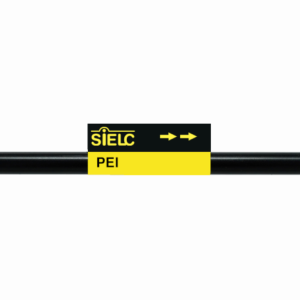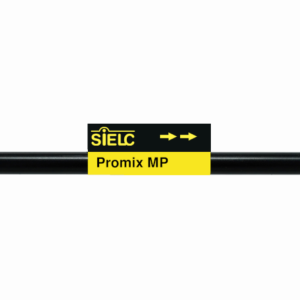Applications:
HPLC Method for Analysis of Polyethylenimine (PEI) on PEI Column
January 27, 2023
HPLC Method for Analysis of Polyethylenimine (PEI) on PEI by SIELC Technologies
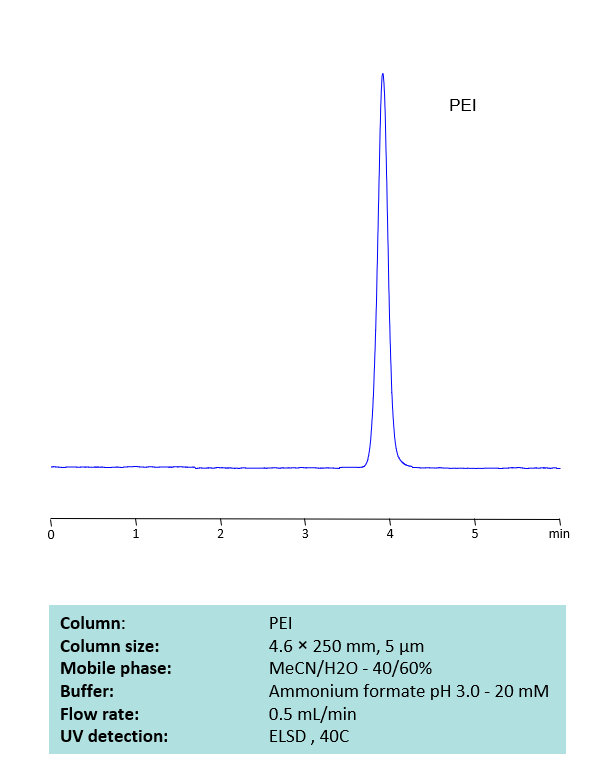
Large multi-charged molecules such as Polyethyleneimine (PEI) can be very difficult to separate and retain on standard columns. PEI is a complex mixture of the molecules of different sizes and geometries with various biological and pharmaceutical applications, such as in tissue cultures, as a transfection reagent, and in carbon dioxide capture. PEI also lacks a UV chromophore, making it difficult to analyze with a standard UV detector.
SIELC’s new PEI column was designed specifically for the analysis of PEI by ion-exclusion and size-exclusion mechanisms. This method uses a simple isocratic mobile phase of Acetonitrile (MeCN) and water with an ammonium formate (AmFm) buffer. This method can be analyzed with high resolution and peak symmetry via any evaporative detector (including ELSD, CAD, and ESI-MS), removing the need for the use of a Copper(II) complex.
High Performance Liquid Chromatography (HPLC) Method for Analysis of PEI
Condition
| Column | PEI, 4.6×250 mm, 5 µm, 100A |
| Mobile Phase | MeCN/H2O – 40/60% |
| Buffer | Ammonium Formate pH 3.0 – 20 mM |
| Flow Rate | 0.5 ml/min |
| Detection | ELSD, 40C |
| Peak Retention Time | 3.81 min |
Description
| Class of Compounds | Drug |
| Analyzing Compounds | Polyethylenimine (PEI) |
Application Column

HPLC Determination of PEI complex with Cu(II)
June 11, 2019
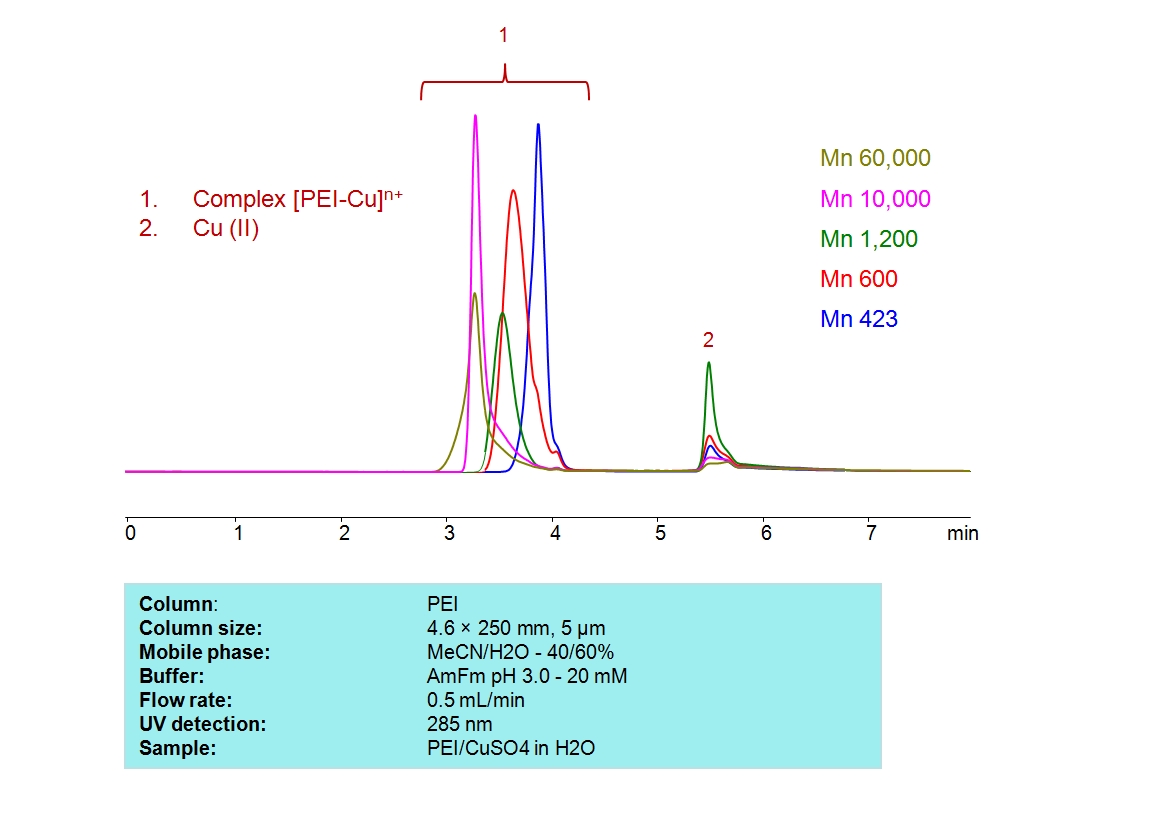
Polyethyleneimine (PEI) is a polymer used in a wide range of applications. It is difficult to analyze in HPLC due to several factors. It’s a mixture of compounds with different lengths and therefore different number of charges. It also lacks a UV chromophore. New PEI column was designed specifically for the analysis of polyethyleneimine by ion-exclusion and size-exclusion mechanisms with copper complex to allow for UV detection. The method uses a mobile phase of acetonitrile (ACN) and water with ammonium formate buffer (AmFm) and UV detection at 285nm.
MEASURING PEI Polyethylenimine in biological samples
| Column | PEI, 4.6×250 mm, 5 µm, 100A |
| Mobile Phase | MeCN/H2O – 40/60% |
| Buffer | AmFM pH 3.0 – 20 mM |
| Flow Rate | 0.5 ml/min |
| Detection | UV, 285 nm |
| Class of Compounds |
Polymer, Basic, Hydrophilic, Ionizable |
| Analyzing Compounds | PEI |
Application Column
PEI
SIELC Technologies offers custom phases for customers who require specific separations not achievable with commercially available HPLC phases. Considering the vast array of compounds and mixtures requiring analysis, tailored LC phases can significantly enhance separation results for unique and challenging applications. To learn more about our special custom LC phases designed for your specific separation needs, please contact SIELC Technologies at research@sielc.com. Our team of experts is ready to guide you through the process and create a custom solution that addresses your particular chromatographic challenges.
Select options
HPLC Analysis of Polyethylenimine in Plasma
June 4, 2010
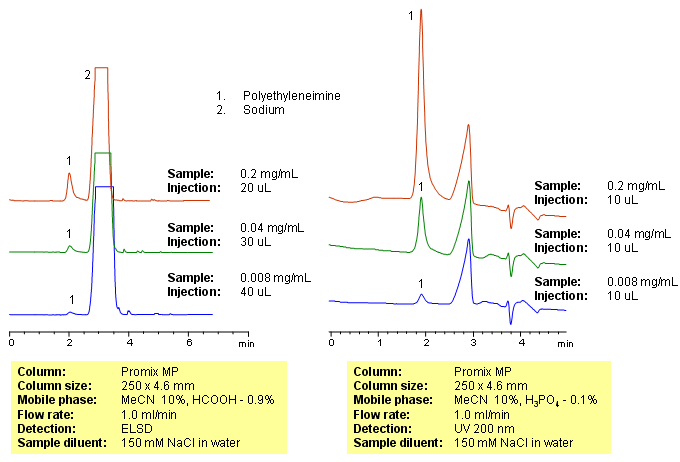
Polyethylenimine is an amino-based hydrophilic polymer. Polyethyleneimine are used in the cell culture of weakly anchoring cells to increase attachment. Due to the fact that it is a complex mixture of polymers with different molecular weight it is very hard to obtain a single sharp peak for this compound. Polyethylenimine was analyzed on a Promix MP column. The method can be used for quantitation of polyethyleneimines in plasma, blood, saliva and other biological fluids. ELSD and LC/MS methods can be employed for detection.
Application Column
Promix MP
The Promix family of mixed-mode columns presents an innovative chromatography technology for the efficient resolution of peptides and proteins. This technology hinges on a unique blend of hydrophobic and ionic interactions, facilitated by a novel separation medium: a ligand bonded to a silica support, chemically combined with hydrophobic and ionic functional groups. This phase provides unparalleled selectivity and peak capacity. By independently adjusting the quantities of buffer and organic modifier, a virtually infinite number of separation conditions can be achieved, rendering it suitable for a wide array of biomolecules.
Select optionsUV Detection


